Diversity and Functional Roles of Root-Associated Endophytic Fungi in Two Dominant Pioneer Trees Reclaimed from a Metal Mine Slag Heap in Southwest China
Abstract
:1. Introduction
2. Materials and Methods
2.1. Study Site and Sample Collection
2.2. Colonization of DSEs and AMF
2.3. DSE Isolation and Identification
2.4. Analysis of Root-Associated Endophytic Fungi by Molecular Approach
2.5. Tolerance of Fungal Isolates to Cd Stress
2.6. Determination of Dissolving Phosphorus
2.7. Determination of Siderophore Production
2.8. Determination of Indole-3-Acetic Acid (IAA)
2.9. Alleviation of Metal Stress by DSEs in P. yunnanensis
2.10. Statistical Analysis
3. Results
3.1. Colonization of the Two Plant Roots by AMF and DSEs
3.2. Diversity of Culturable DSEs in the Roots of Two Pioneer Plant Species
3.3. Diversity of Root-Associated Endophytic Fungi in the Roots of the Two Plant Species
3.4. Cadmium Tolerance of Culturable Root-Associated Endophytic Fungi
3.5. Phosphorus Solubilizin Ability of the Six Representative DSE Strains
3.6. Siderophore Production of the Six Representative DSE Strains
3.7. Indole-3-Acetic Acid (IAA) Production of the Six Representative DSE Strains
3.8. The Effect of DSE Inoculation on the Growth of P. yunnanensis
4. Discussion
5. Conclusions
Supplementary Materials
Author Contributions
Funding
Data Availability Statement
Conflicts of Interest
References
- Trivedi, P.; Leach, J.E.; Tringe, S.G.; Sa, T.; Singh, B.K. Plant-microbiome interactions: From community assembly to plant health. Nat. Rev. Microbiol. 2020, 18, 607–621. [Google Scholar] [CrossRef]
- Solomon, W.; Janda, T.; Molnár, Z. Unveiling the significance of rhizosphere: Implications for plant growth, stress response, and sustainable agriculture. Plant Physiol. Bioch. 2024, 206, 108290. [Google Scholar] [CrossRef] [PubMed]
- Ruotsalainen, A.L.; Kauppinen, M.; Wäli, P.R.; Saikkonen, K.; Helander, M.; Tuomi, J. Dark septate endophytes: Mutualism from by-products? Trends Plant Sci. 2022, 27, 247–254. [Google Scholar] [CrossRef] [PubMed]
- Jumpponen, A.; Trappe, J.M. Dark septate endophytes: A review of facultative biotrophic root-colonizing fungi. New Phytol. 1998, 140, 295–310. [Google Scholar] [CrossRef]
- Newsham, K.K.; Upson, R.; READ, D.J. Mycorrhizas and dark septate root endophytes in polar regions. Fungal Ecol. 2009, 2, 10–20. [Google Scholar] [CrossRef]
- Lehnert, M.; Krug, M.; Kessler, M. A review of symbiotic fungal endophytes in lycophytes and ferns—A global phylogenetic and ecological perspective. Symbiosis 2017, 71, 77–89. [Google Scholar] [CrossRef]
- Malicka, M.; Magurno, F.; Piotrowska-Seget, Z. Plant association with dark septate endophytes: When the going gets tough (and stressful), the tough fungi get going. Chemosphere 2022, 302, 134830. [Google Scholar] [CrossRef]
- Santos, M.; Cesanelli, I.; Diánez, F.; Sánchez-Montesinos, B.; Moreno-Gavíra, A. Advances in the role of dark septate endophytes in the plant resistance to abiotic and biotic stresses. J. Fungi 2021, 7, 939. [Google Scholar] [CrossRef]
- Casanova-Katny, M.A.; Torres-Mellado, G.A.; Palfner, G.; Cavieres, L.A. The best for the guest: High Andean nurse cushions of Azorella madreporica enhance arbuscular mycorrhizal status in associated plant species. Mycorrhiza 2011, 21, 613–622. [Google Scholar] [CrossRef]
- Liu, H.; Li, T.; Ding, Y.; Yang, Y.; Zhao, Z. Dark septate endophytes colonizing the roots of ‘non-mycorrhizal’ plants in a mine tailing pond and in a relatively undisturbed environment, Southwest China. J. Plant Interact. 2017, 12, 264–271. [Google Scholar] [CrossRef]
- Netherway, T.; Bengtsson, J.; Buegger, F.; Fritscher, J.; Oja, J.; Pritsch, K.; Hildebrand, F.; Krab, E.J.; Bahram, M. Pervasive associations between dark septate endophytic fungi with tree root and soil microbiomes across Europe. Nat. Commun. 2024, 15, 159. [Google Scholar] [CrossRef] [PubMed]
- Li, X.; He, X.; Hou, L.; Ren, Y.; Wang, S.; Su, F. Dark septate endophytes isolated from a xerophyte plant promote the growth of Ammopiptanthus mongolicus under drought condition. Sci. Rep. 2018, 8, 7896. [Google Scholar] [CrossRef]
- Deng, X.; Song, X.; Halifu, S.; Yu, W.; Song, R. Effects of dark septate endophytes strain A024 on damping-off biocontrol, plant growth and the rhizosphere soil enviroment of Pinus sylvestris var. mongolica annual seedlings. Plants 2020, 9, 913. [Google Scholar] [CrossRef] [PubMed]
- Xu, R.; Li, T.; Shen, M.; Yang, Z.L.; Zhao, Z. Evidence for a dark septate endophyte (Exophiala Pisciphila, H93) enhancing phosphorus absorption by maize seedlings. Plant Soil 2020, 452, 249–266. [Google Scholar] [CrossRef]
- Akhtar, N.; Wani, A.K.; Dhanjal, D.S.; Mukherjee, S. Insights into the beneficial roles of dark septate endophytes in plants under challenging environment: Resilience to biotic and abiotic stresses. World J. Microb. Biot. 2022, 38, 79. [Google Scholar] [CrossRef]
- Qu, D.; Wu, F.; Guo, Y.; Zhang, J.; Li, M.; Yang, L.; Wang, L.; Su, H. Dark septate endophyte Anteaglonium sp. T010 promotes biomass accumulation in poplar by regulating sucrose metabolism and hormones. Tree Physiol. 2024, 44, tpae057. [Google Scholar] [CrossRef]
- Wang, J.; Li, T.; Liu, G.; Smith, J.M.; Zhao, Z. Unraveling the role of dark septate endophyte (DSE) colonizing maize (Zea mays) under cadmium stress: Physiological, cytological and genic aspects. Sci. Rep. 2016, 6, 22028. [Google Scholar] [CrossRef]
- Lopez, R.O.; Chiocchio, V.M.; Ruscitti, M.F.; Taborda, C.P.; Saparrat, M.C.N. Towards a better understanding of melanins from dark septate endophytes (DSEs): Their variability, synthesis pathways and biological roles. J. Soil Sci. Plant Nutr. 2024, 24, 1650–1664. [Google Scholar] [CrossRef]
- Hou, L.; Yu, J.; Zhao, L.; He, X. Dark septate endophytes improve the growth and the tolerance of Medicago sativa and Ammopiptanthus mongolicus under cadmium stress. Front. Microbiol. 2019, 10, 3061. [Google Scholar] [CrossRef]
- Zhou, Y.; Zheng, Y.; Li, P.; Xu, L.; Fu, Q. Ectomycorrhizal fungi and dark septate endophyte inoculation improve growth and tolerance of Pinus tabulaeformis under cadmium stress. Pedosphere 2024, 34, 473–483. [Google Scholar] [CrossRef]
- Deram, A.; Languereau, F.; Haluwyn, C.V. Mycorrhizal and endophytic fungal colonization in Arrhenatherum elatius L. roots according to the soil contamination in heavy metals. Soil Sediment Contam. 2011, 20, 114–127. [Google Scholar] [CrossRef]
- He, W.; Megharaj, M.; Wu, C.Y.; Subashchandrabose, S.R.; Dai, C.C. Endophyte-assisted phytoremediation: Mechanisms and current application strategies for soil mixed pollutants. Crit. Rev. Biotechnol. 2020, 40, 31–45. [Google Scholar] [CrossRef] [PubMed]
- Rossini-Oliva, S.; Abreu, M.M.; Leidi, E.O. Strategies in a metallophyte species to cope with manganese excess. Environ. Geochem. Health 2021, 43, 1523–1535. [Google Scholar] [CrossRef] [PubMed]
- Midhat, L.; Ouazzani, N.; Aziz, F.; Esshaimi, M.; Hejjaj, A.; Mandi, L. Screening of new native metallophytes from copper abandoned mining site: Promising tool for phytoremediation. Land Degrad. Dev. 2023, 34, 3700–3711. [Google Scholar] [CrossRef]
- Hou, X.Y.; Liu, S.L.; Cheng, F.Y.; Zhang, Y.Q.; Dong, S.K.; Su, X.K.; Liu, G.H. Vegetation community composition along disturbance gradients of four typical open-pit mines in Yunnan Province of southwest China. Land Degrad. Dev. 2019, 30, 437–447. [Google Scholar] [CrossRef]
- Peng, S.; Wu, L.; Seyler, B.C.; Pei, X.; Li, S.; Huang, Y. The combined effects of Cu and Pb on the sex-specific growth and physiology of the dioecious Populus yunnanensis. Environ. Res. 2020, 184, 109276. [Google Scholar] [CrossRef]
- Berch, S.M.; Kendrick, B. Vesicular-arbuscular mycorrhizae of southern Ontrario ferns and fern-allies. Mycologia 1982, 74, 769–776. [Google Scholar] [CrossRef]
- McGonigle, T.P.; Miller, M.H.; Evans, D.G.; Fairchild, G.L.; Swan, J.A. A new method which gives an objective measure of colonization of roots by vesicular–arbuscular mycorrhizal fungi. New Phytol. 1990, 115, 495–501. [Google Scholar] [CrossRef]
- Xu, R.; Li, T.; Cui, H.; Wang, J.; Yu, X.; Ding, Y.; Wang, C.; Yang, Z.; Zhao, Z. Diversity and characterization of Cd-tolerant dark septate endophytes (DSEs) associated with the roots of Nepal alder (Alnus nepalensis) in a metal mine tailing of southwest China. Appl. Soil Ecol. 2015, 93, 11–18. [Google Scholar] [CrossRef]
- Billon-Grand, G.; Fiol, J.B.; Breton, A.; Bruyère, A.; Oulhaj, Z. DNA of some anaerobic rumen fungi: G + C content determination. FEMS Microbiol. Lett. 1991, 82, 267–270. [Google Scholar] [CrossRef]
- White, T.J.; Bruns, T.; Lee, S.; Taylor, J. Amplification and direct sequencing of fungal ribosomal RNA genes for phylogenetics. In PCR Protocols: A Guide to Methods and Applications; Innis, M.A., Gelfand, D.H., Eds.; Academic Press: London, UK, 1990; pp. 315–322. [Google Scholar] [CrossRef]
- Tedersoo, L.; Bahram, M.; Põlme, S.; Kõljalg, U.; Yorou, N.S.; Wijesunderam, R.; Ruiz, L.V.; Vasco-Palacios, A.M.; Thu, P.Q.; Suija, A.; et al. Global diversity and geography of soil fungi. Science 2014, 346, 1256688. [Google Scholar] [CrossRef] [PubMed]
- Xiong, W.; Li, R.; Ren, Y.; Liu, C.; Zhao, Q.; Wu, H.; Jousset, A.; Shen, Q. Distinct roles for soil fungal and bacterial communities associated with the suppression of vanilla Fusarium wilt disease. Soil Biol. Biochem. 2017, 107, 198–207. [Google Scholar] [CrossRef]
- Caporaso, J.G.; Kuczynski, J.; Stombaugh, J.; Bittinger, K.; Bushman, F.D.; Costello, E.K.; Fierer, N.; Peña, A.G.; Goodrich, J.K.; Gordon, J.I.; et al. QIIME allows analysis of high-throughput community sequencing data. Nat. Methods 2010, 7, 335–336. [Google Scholar] [CrossRef] [PubMed]
- Bjorbækmo, M.F.M.; Carlsen, T.; Brysting, A.; Vrålstad, T.; Høiland, K.; Ugland, K.I.; Geml, J.; Schumacher, T.; Kauserud, H. High diversity of root associated fungi in both alpine and arctic Dryas octopetala. BMC Plant Biol. 2010, 10, 244. [Google Scholar] [CrossRef]
- Nilsson, R.H.; Larsson, K.H.; Taylor, A.F.S.; Bengtsson-Palme, J.; Jeppesen, T.S.; Schigel, D.; Kennedy, P.; Picard, K.; Glockner, F.O.; Tedersoo, L.; et al. The UNITE database for molecular identification of fungi: Handling dark taxa and parallel taxonomic classifications. Nucleic Acids Res. 2019, 47, D259–D264. [Google Scholar] [CrossRef]
- Lozupone, C.; Hamady, M.; Knight, R. UniFrac—An online tool for comparing microbial community diversity in a phylogenetic context. BMC Bioinform. 2006, 7, 371. [Google Scholar] [CrossRef]
- Fan, Z.Z.; Lu, S.Y.; Liu, S.; Guo, H.; Wang, T.; Zhou, J.X.; Peng, X.W. Changes in plant rhizosphere microbial communities under different vegetation restoration patterns in karst and non-karst ecosystems. Sci. Rep. 2019, 9, 8761. [Google Scholar] [CrossRef]
- Ren, Y.; Yu, G.; Shi, C.; Liu, L.; Guo, Q.; Han, C.; Zhang, D.; Zhang, L.; Liu, B.; Gao, H.; et al. Majorbio Cloud: A one-stop, comprehensive bioinformatic platform for multiomics analyses. iMeta 2022, 1, e12. [Google Scholar] [CrossRef]
- Berthelot, C.; Leyval, C.; Foulon, J.; Chalot, M.; Blaudez, D. Plant growth promotion, metabolite production and metal tolerance of dark septate endophytes isolated from metal-polluted poplar phytomanagement sites. FEMS Microbiol. Ecol. 2016, 92, fiw144. [Google Scholar] [CrossRef]
- Murphy, J.; Riley, J.P. A modified single solution method for the determination of phosphate in natural waters. Anal. Chim. Acta 1962, 27, 31–36. [Google Scholar] [CrossRef]
- Watanabe, F.S.; Olsen, S.R. Test of an ascorbic acid method for determining phosphorus in water and NaHCO3 extracts from soil. Soil Sci. Soc. Am. J. 1965, 29, 677–678. [Google Scholar] [CrossRef]
- Milagres, A.M.F.; Machuca, A.; Napoleão, D. Detection of siderophore production from several fungi and bacteria by a modification of chrome azurol S (CAS) agar plate assay. J. Microbiol. Methods 1999, 37, 1–6. [Google Scholar] [CrossRef] [PubMed]
- Kashem, M.A.; Singh, B.R.; Kondo, T.; Huq, S.M.I.; Kawai, S. Comparison of extractability of Cd, Cu, Pb and Zn with sequential extraction in contaminated and non-contaminated soils. Int. J. Environ. Sci. Technol. 2007, 4, 169–176. [Google Scholar] [CrossRef]
- Yin, Z.; Zhang, Y.; Hu, N.; Shi, Y.; Li, T.; Zhao, Z. Differential responses of 23 maize cultivar seedlings to an arbuscular mycorrhizal fungus when grown in a metal-polluted soil. Sci. Total Environ. 2021, 789, 148015. [Google Scholar] [CrossRef] [PubMed]
- Jean, R.; Khasa, D.; Boudreau, S. Effects of one dark septate endophytic fungal and two Helotiales strains on the growth of Salix planifolia cuttings on iron ore waste rock. Botany 2021, 99, 725–733. [Google Scholar] [CrossRef]
- Tsiknia, M.; Skiada, V.; Ipsilantis, I.; Vasileiadis, S.; Kavroulakis, N.; Genitsaris, S.; Papadopoulou, K.K.; Hart, M.; Klironomos, J.; Karpouzas, D.G.; et al. Strong host-specific selection and over-dominance characterize arbuscular mycorrhizal fungal root colonizers of coastal sand dune plants of the Mediterranean region. FEMS Microbiol. Ecol. 2021, 97, fiab109. [Google Scholar] [CrossRef]
- Loo, E.P.I.; Duran, P.; Pang, T.Y.; Westhoff, P.; Deng, C.; Duran, C.; Lercher, M.; Garrido-Oter, R.; Frommer, W.B. Sugar transporters spatially organize microbiota colonization along the longitudinal root axis of Arabidopsis. Cell Host Microbe 2024, 32, 543–556. [Google Scholar] [CrossRef]
- Jones, S.L.; French, K. Soil nutrients differentially influence root colonisation patterns of AMF and DSE in Australian plant species. Symbiosis 2021, 83, 209–223. [Google Scholar] [CrossRef]
- Meesters, C.; Cialdella, L.; Ingels, R.; Jacquemyn, H.; Lievens, B. Cultivar-dependent effects of plant-beneficial fungi on plant nutrient composition and feeding damage by Nesidiocoris tenuis. Plant Soil 2023, 492, 177–190. [Google Scholar] [CrossRef]
- Bennett, A.E.; Groten, K. The costs and benefits of plant–arbuscular mycorrhizal fungal interactions. Annu. Rev. Plant Biol. 2022, 73, 649–672. [Google Scholar] [CrossRef]
- Koskella, B.; Bergelson, J. The study of host–microbiome (co)evolution across levels of selection. Philos. Trans. R. Soc. B 2020, 375, 20190604. [Google Scholar] [CrossRef] [PubMed]
- Santini, T.C.; Raudsepp, M.; Hamilton, J.; Nunn, J. Extreme geochemical conditions and dispersal limitation retard primary succession of microbial communities in gold tailings. Front. Microbiol. 2018, 9, 2785. [Google Scholar] [CrossRef]
- Ossanna, L.Q.R.; Serrano, K.; Jennings, L.L.; Dillon, J.; Maier, R.M.; Neilson, J.W. Progressive belowground soil development associated with sustainable plant establishment during copper mine waste revegetation. Appl. Soil Ecol. 2023, 186, 104813. [Google Scholar] [CrossRef]
- Harris, J. Soil microbial communities and restoration ecology: Facilitators or followers? Science 2009, 325, 573–574. [Google Scholar] [CrossRef]
- de Prado, I.G.O.; Veloso, T.G.R.; da Luz, J.M.R.; da Silva, M.d.C.S.; de Prado, D.G.O.; Parsons, W.F.J.; Khasa, D.P.; Kasuya, M.C.M. Total and arbuscular mycorrhizal fungal communities in the first 3 years after the collapse of the Fundão Dam: Are we on the ecosystem recovery pathway? Restor. Ecol. 2023, 31, e13954. [Google Scholar] [CrossRef]
- Gagnon, V.; Rodrigue-Morin, M.; Tremblay, J.; Wasserscheid, J.; Champagne, J.; Bellenger, J.P.; Greer, C.W.; Roy, S. Life in mine tailings: Microbial population structure across the bulk soil, rhizosphere, and roots of boreal species colonizing mine tailings in northwestern Québec. Ann. Microbiol. 2020, 70, 41. [Google Scholar] [CrossRef]
- Flemer, B.; Gulati, S.; Bergna, A.; Rändler, M.; Cernava, T.; Witzel, K.; Berg, G.; Grosch, R. Biotic and abiotic stress factors induce microbiome shifts and enrichment of distinct beneficial bacteria in tomato roots. Phytobiomes J. 2022, 6, 276–289. [Google Scholar] [CrossRef]
- Parasar, B.J.; Sharma, I.; Agarwala, N. Root exudation drives abiotic stress tolerance in plants by recruiting beneficial microbes. Appl. Soil Ecol. 2024, 198, 105351. [Google Scholar] [CrossRef]
- Kulczyk-Skrzeszewska, M.; Kieliszewska-Rokicka, B. Influence of drought and salt stress on the growth of young Populus nigra ‘Italica’ plants and associated mycorrhizal fungi and non-mycorrhizal fungal endophytes. New For. 2022, 53, 679–694. [Google Scholar] [CrossRef]
- Zhang, Y.; Li, T.; Li, L.; Zhao, Z. The colonization of plants by dark septate endophytes (DSE) in the valley-type savanna of Yunnan, southwest China. Afr. J. Microbiol. Res. 2011, 5, 5540–5547. [Google Scholar] [CrossRef]
- Huang, J.; Zhao, Z.; Chen, G.; Liu, H. Host range of Frankia endophytes. Plant Soil 1985, 87, 61–65. [Google Scholar] [CrossRef]
- Liu, D.; Zheng, K.; Wang, Y.; Zhang, Y.; Lao, R.; Qin, Z.; Li, T.; Zhao, Z. Harnessing an arbuscular mycorrhizal fungus to improve the adaptability of a facultative metallophytic poplar (Populus yunnanensis) to cadmium stress: Physiological and molecular responses. J. Hazard. Mater. 2022, 424, 127430. [Google Scholar] [CrossRef] [PubMed]
- Lei, D.; Duan, C. Restoration potential of pioneer plants growing on lead-zinc mine tailings in Lanping, southwest China. J. Environ. Sci. 2008, 20, 1202–1209. [Google Scholar] [CrossRef]
- Soto, J.; Sanhueza, T.; Ortiz, J.; Mora, M.d.l.L.; Garcia-Romera, I.; Arriagada, C. Plant growth-promotion and abiotic stress tolerance of dark septate endophyte fungi isolated from roots of native Andean Ericaceae plants colonizing volcanic deposits in southern Chile. J. Soil Sci. Plant Nutr. 2024, 24, 5144–5153. [Google Scholar] [CrossRef]
- Surono; Narisawa, K. The dark septate endophytic fungus Phialocephala fortinii is a potential decomposer of soil organic compounds and a promoter of Asparagus officinalis growth. Fungal Ecol. 2017, 28, 1–10. [Google Scholar] [CrossRef]
- Spagnoletti, F.N.; Tobar, N.E.; Pardo, A.F.D.; Chiocchio, V.M.; Lavado, R.S. Dark septate endophytes present different potential to solubilize calcium, iron and aluminum phosphates. Appl. Soil Ecol. 2017, 111, 25–32. [Google Scholar] [CrossRef]
- Hengodage, N.B.W.; Ruotsalainen, A.L.; Markkola, A.; Häggman, H. Root fungal colonisations of the understory grass Deschampsia flexuosa after top-canopy harvesting. Plant Soil 2016, 414, 171–180. [Google Scholar] [CrossRef]
- Ruotsalainen, A.L. Dark Septate Endophytes (DSE) in Boreal and Subarctic Forests. In Endophytes of Forest Trees; Forestry Sciences; Pirttilä, A., Frank, A., Eds.; Springer: Cham, Switzerland, 2018; Volume 86. [Google Scholar] [CrossRef]
- Newsham, K.K. A meta-analysis of plant responses to dark septate root endophytes. New Phytol. 2011, 190, 783–793. [Google Scholar] [CrossRef]
- Della Mónica, I.F.; Saparrat, M.C.N.; Godeas, A.M.; Scervino, J.M. The co-existence between DSE and AMF symbionts affects plant P pools through P mineralization and solubilization processes. Fungal Ecol. 2015, 17, 10–17. [Google Scholar] [CrossRef]
- Luo, Q.; Hou, R.; Shang, X.; Li, S. Effects of phosphorus-dissolving dark septate endophytes on the growth of blueberry. J. Microbiol. 2023, 61, 837–851. [Google Scholar] [CrossRef]
- Chen, F.; Ma, J.; Yuan, Q.; Yu, Z. Phosphate solubilizing microorganisms as a driving force to assist mine phytoremediation. Front. Bioeng. Biotechnol. 2023, 11, 1201067. [Google Scholar] [CrossRef] [PubMed]
- Lai, W.; Wu, Y.; Zhang, C.; Dilinuer, Y.; Pasang, L.; Lu, Y.; Wang, Y.; Chen, H.; Li, Z. Combination of biochar and phosphorus solubilizing bacteria to improve the stable form of toxic metal minerals and microbial abundance in lead/cadmium-contaminated Soil. Agronomy 2022, 12, 1003. [Google Scholar] [CrossRef]
- Sukumar, P.; Legue, V.; Vayssieres, A.; Martin, F.; Tuskan, G.A.; Kalluri, U.C. Involvement of auxin pathways in modulating root architecture during beneficial plant-microorganism interactions. Plant Cell Environ. 2013, 36, 909–919. [Google Scholar] [CrossRef] [PubMed]
- Domka, A.M.; Rozpadek, P.; Turnau, K. Are fungal endophytes merely mycorrhizal copycats? The role of fungal endophytes in the adaptation of plants to metal toxicity. Front. Microbiol. 2019, 10, 371. [Google Scholar] [CrossRef] [PubMed]
- Shen, M.; Schneider, H.; Xu, R.; Cao, G.; Zhang, H.; Li, T.; Zhao, Z. Dark septate endophyte enhances maize cadmium (Cd) tolerance by the remodeled host cell walls and the altered Cd subcellular distribution. Environ. Exp. Bot. 2020, 172, 104000. [Google Scholar] [CrossRef]
- Li, M.S. Ecological restoration of mineland with particular reference to the metalliferous mine wasteland in China: A review of research and practice. Sci. Total Environ. 2006, 357, 38–53. [Google Scholar] [CrossRef]
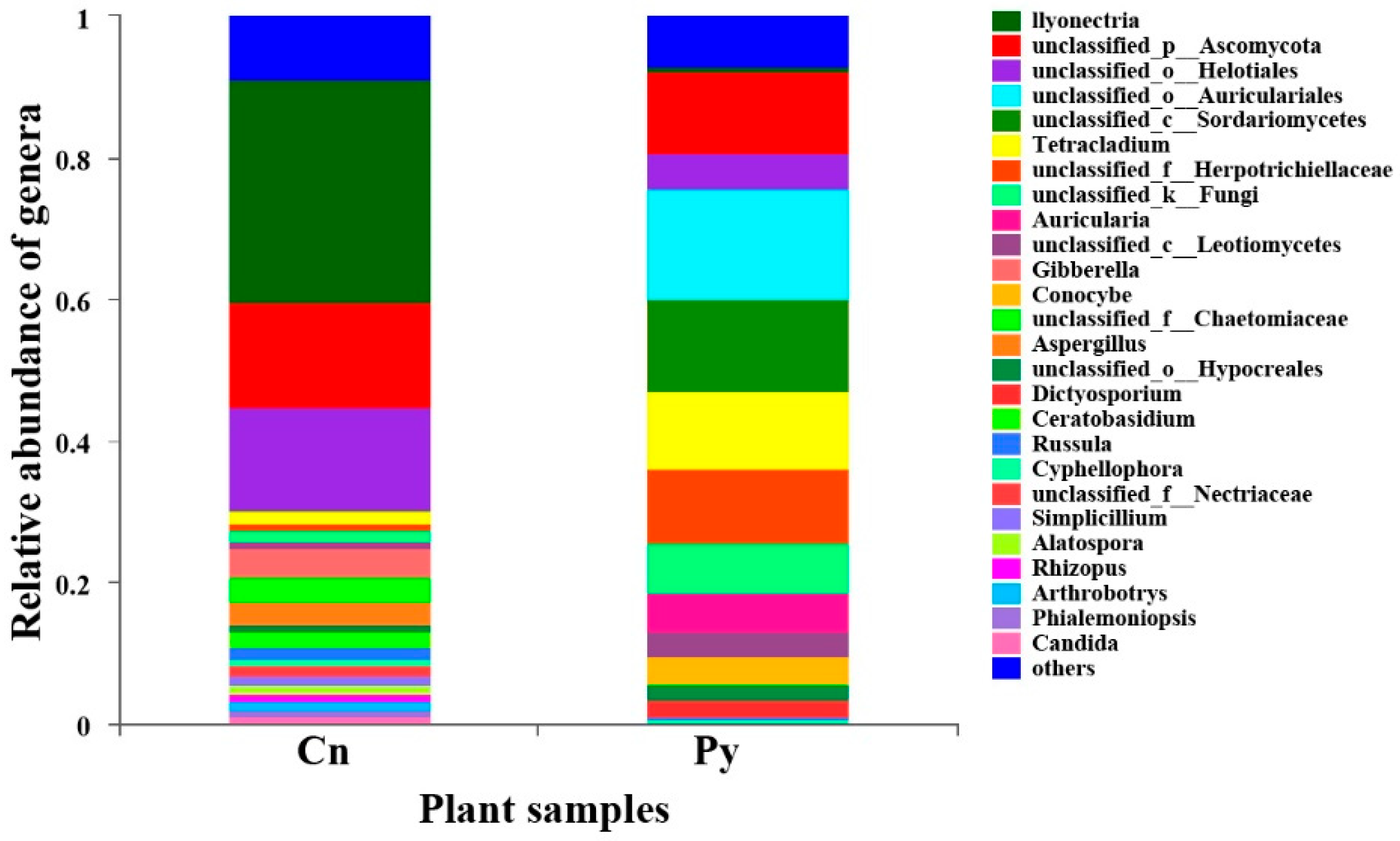
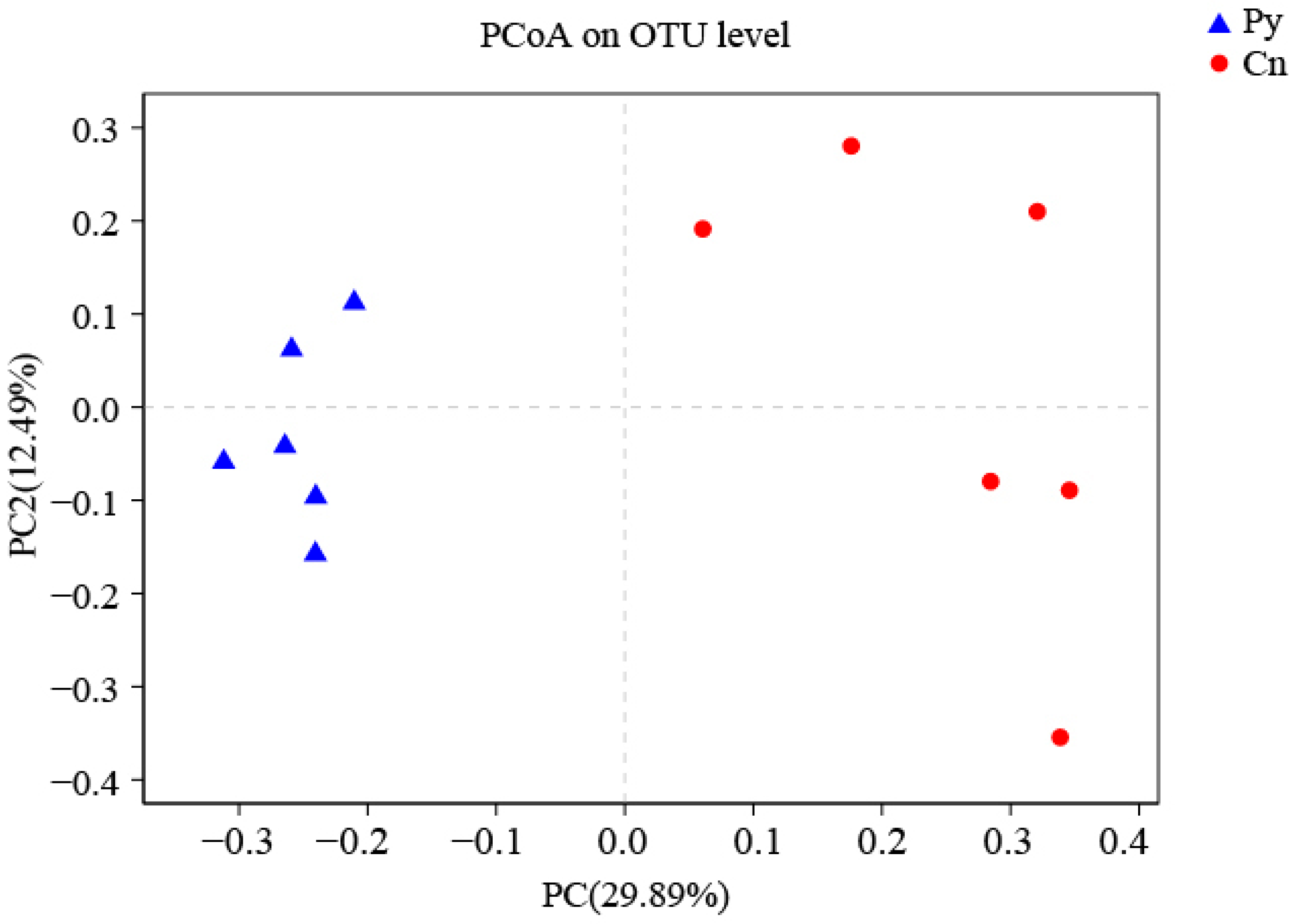
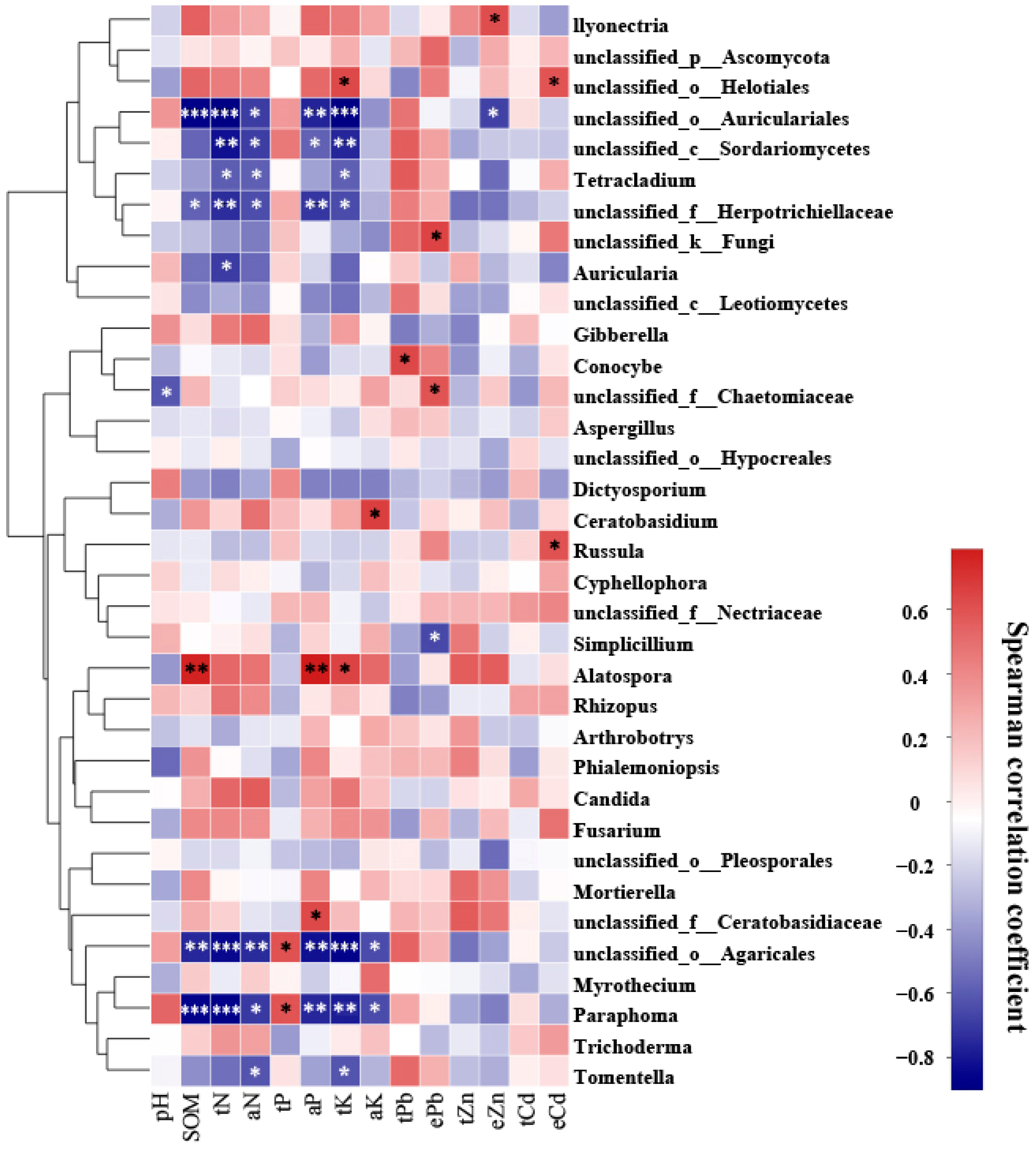
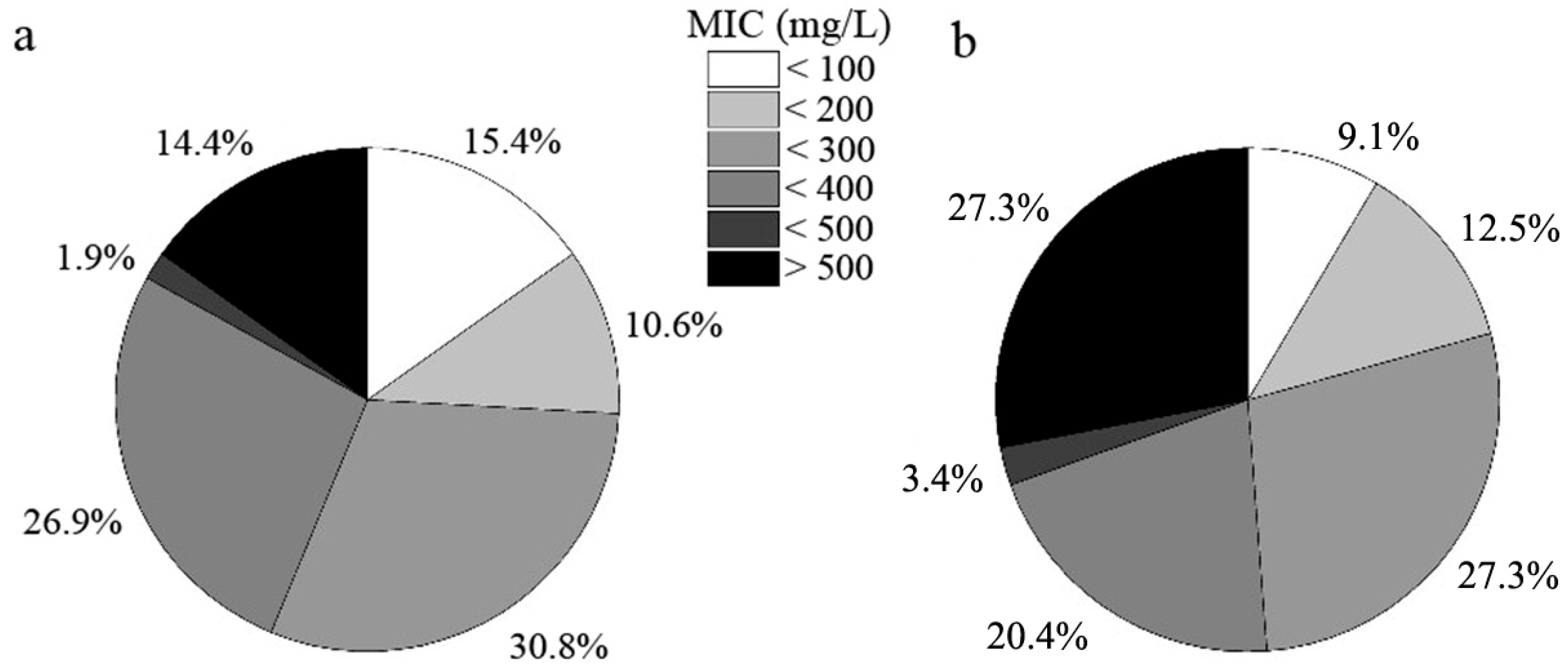
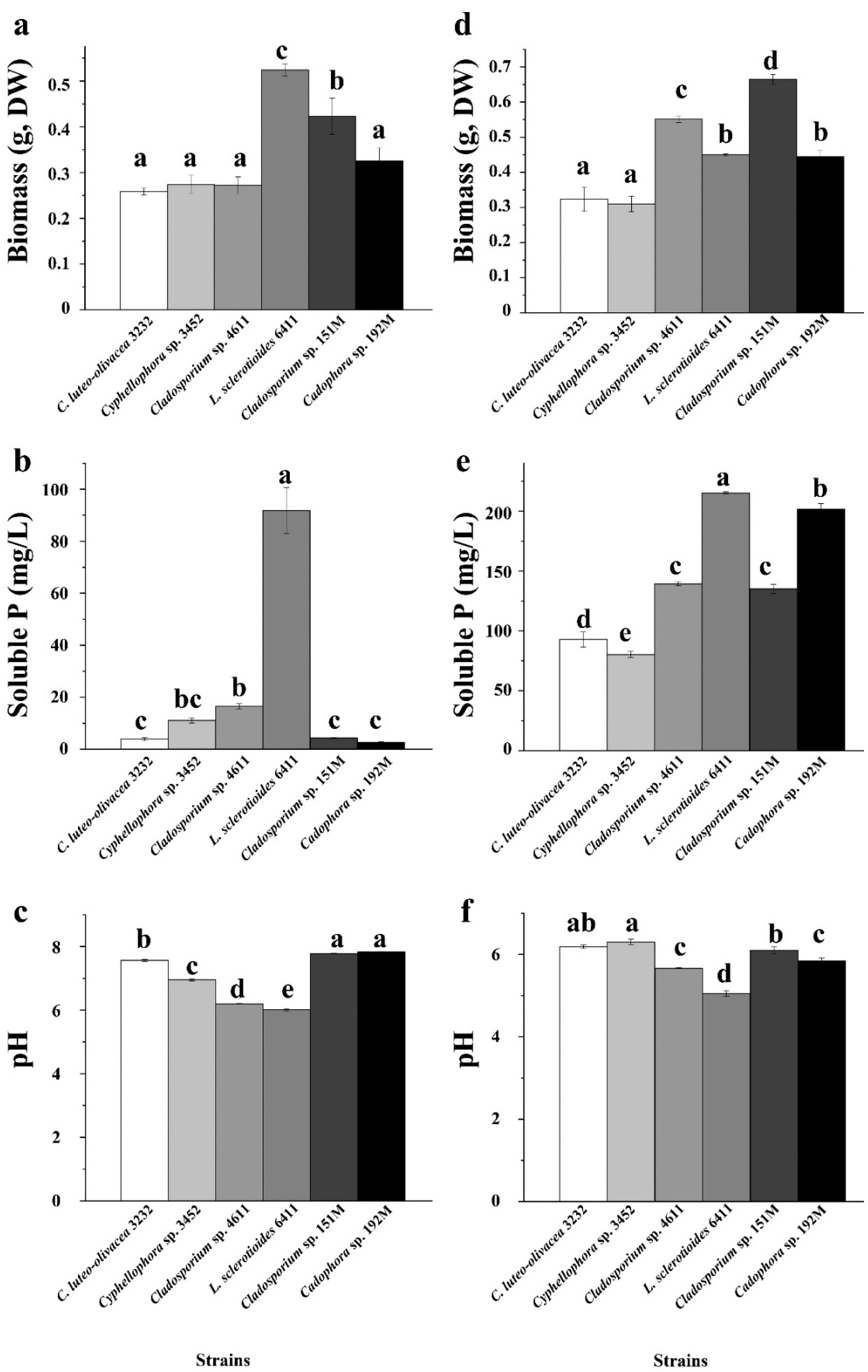

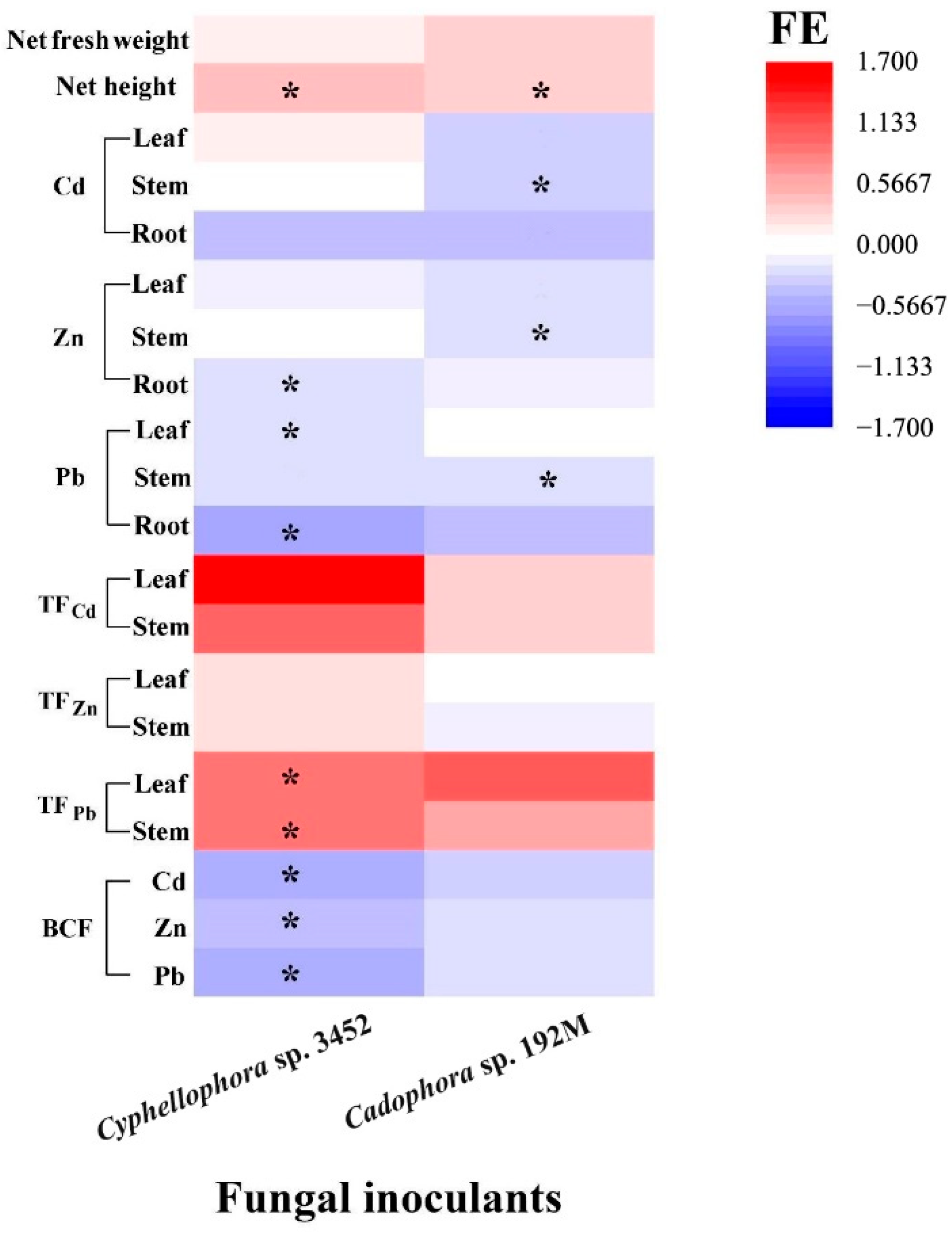
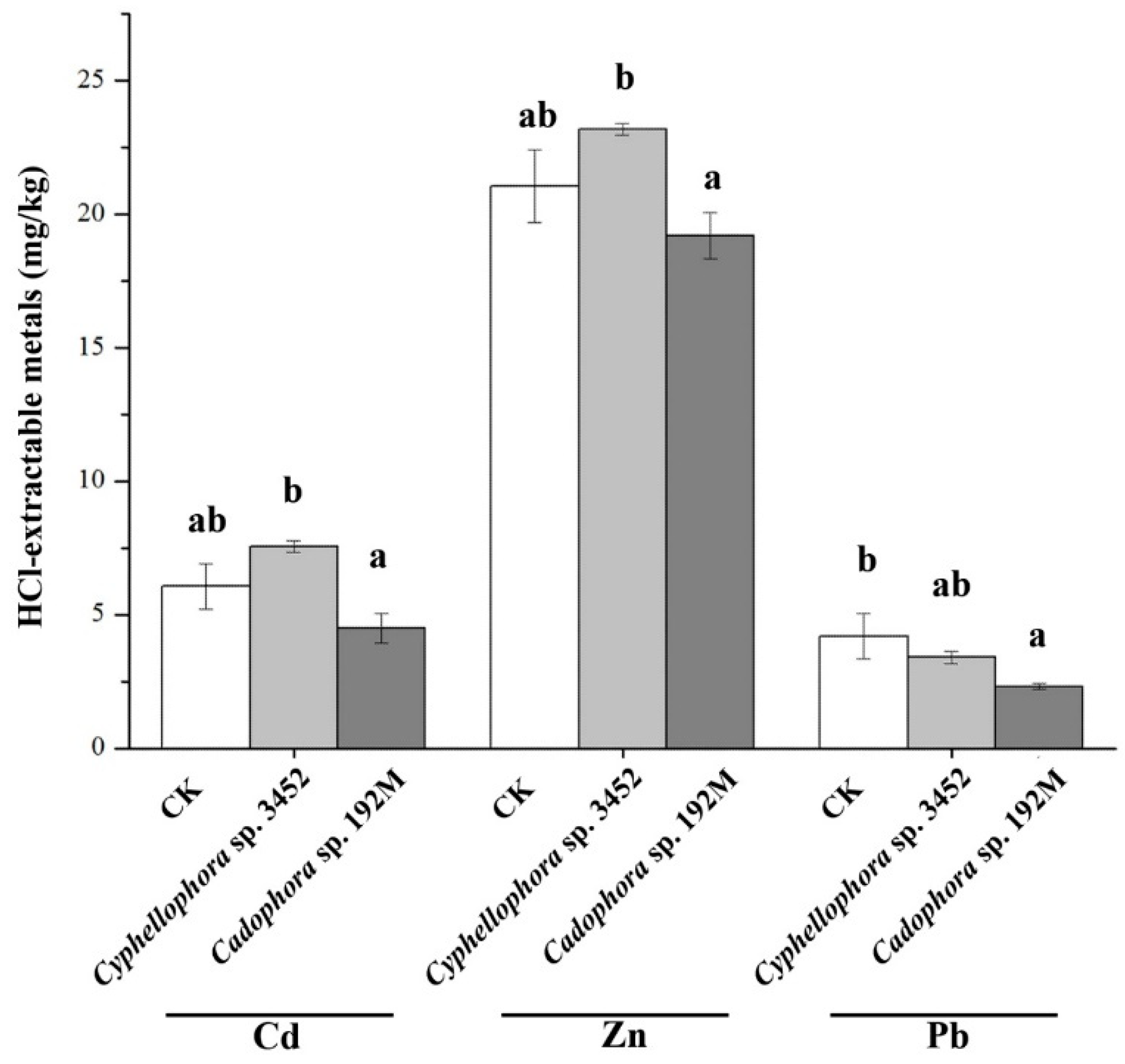
| Fungal Structures | P. yunnanensis | C. sinica |
|---|---|---|
| DSEs | ||
| Hyphae | 72.2 ± 3.0% a | 36.6 ± 0.8% b |
| Microsclerotia | 1.3 ± 0.2% a | 1.5 ± 0.5% a |
| Total | 73.5 ± 3.0% a | 37.4 ± 0.8% b |
| AMF | ||
| Hyphae | 55.8 ± 1.2% a | 49.5 ± 0.7% b |
| Arbuscules | 5.4 ± 0.6% a | 3.0 ± 0.5% b |
| Hyphal coils | 0.1 ± 0.1% a | 0.1 ± 0.1% a |
| Vesicles | 5.4 ± 0.9% a | 2.2 ± 0.4% b |
| Total | 66.7 ± 1.6% a | 54.7 ± 0.8% b |
| Isolates | Accession No. | Strain No. | Frequencies (%) | The Best BLAST Hits in UNITE | |||
|---|---|---|---|---|---|---|---|
| Organism ITS Identified | UNITE SH Code at 1.5% Threshold | Accession No. | % ITS Identity | ||||
| Podospora | 0.52 | ||||||
| 3793 | OP689613 | 1 | Podospora | SH0733809.10FU | HM161911 | 98.14 | |
| Humicola | 3.65 | ||||||
| 3751 | OP689614 | 7 | H. fuscoatra | SH0758021.10FU | KT291422 | 94.58 | |
| Cadophora | 35.42 | ||||||
| 3621 | OP689584 | 7 | Cadophora | SH1011920.10FU | KT203128 | 100 | |
| 251M | OP689591 | 3 | Cadophora | SH1011920.10FU | KT269343 | 100 | |
| 192M | OP689615 | 55 | Cadophora | SH1011920.10FU | MZ674486 | 99.65 | |
| 3232 | OP689588 | 3 | C. luteo-olivacea | SH1011920.10FU | OR761595 | 99.83 | |
| Chaetomium | 2.6 | ||||||
| 73P | OP689600 | 1 | Chaetomium | SH0978756.10FU | MH171491 | 99.62 | |
| 37122 | OP689603 | 4 | Chaetomium | SH0845223.10FU | DQ093790 | 94.5 | |
| Cladosporium | 22.92 | ||||||
| 303M | OP689590 | 2 | Cladosporium | SH0962330.10FU | KX258802 | 100 | |
| 4311 | OP689594 | 39 | Cladosporium | SH0962330.10FU | PP931183 | 99.42 | |
| 75M | OP689599 | 3 | C. sphaerospermum | SH0962330.10FU | OR482603 | 99.81 | |
| Cyphellophora | 7.81 | ||||||
| 3452 | OP689587 | 15 | Cyphellophora | SH0870058.10FU | MT453284 | 99.13 | |
| Didymella | 3.125 | ||||||
| 42Z | OP689602 | 4 | D. bellidis | SH0862152.10FU | OR734621 | 99.6 | |
| 5321 | OP689605 | 2 | D. sinensis | SH0862152.10FU | OP596108 | 100 | |
| Dothistroma | 1.04 | ||||||
| 245P | OP689592 | 2 | Dothistroma | SH0972187.10FU | KC867932 | 99.39 | |
| Endoradiciella | 1.04 | ||||||
| 5131 | OP689607 | 1 | E. communis | SH0948508.10FU | PP951472 | 98.8 | |
| 4321 | OP689609 | 1 | E. communis | SH0948508.10FU | PP951472 | 98.27 | |
| Herpotrichiellaceae | 5.73 | ||||||
| 5292 | OP689606 | 11 | Herpotrichiellaceae | SH1008212.10FU | AF373061 | 98.79 | |
| Leptosphaeria | 1.56 | ||||||
| 6411 | OP689604 | 3 | L. sclerotioides | SH1021671.10FU | PP348000 | 99.43 | |
| Minimelanolocus | 0.52 | ||||||
| 1411 | OP689589 | 1 | Minimelanolocus | SH0904736.10FU | OP626359 | 99.82 | |
| Mycochaetophora | 0.52 | ||||||
| 191P2 | OP689596 | 1 | Mycochaetophora | SH1011920.10FU | MT133926 | 99.47 | |
| Paraphoma | 5.21 | ||||||
| 3512 | OP689585 | 5 | Paraphoma | SH1022010.10FU | KT268530 | 99.42 | |
| 196M | OP689593 | 5 | P. rhaphiolepidis | SH1022010.10FU | OP482452 | 99.42 | |
| Pyrenochaeta | 4.69 | ||||||
| 43P2 | OP689601 | 5 | Pyrenochaeta | SH0991831.10FU | OM743888 | 99.03 | |
| 3511 | OP689586 | 1 | Pyrenochaeta | SH1006324.10FU | FN394710 | 99.62 | |
| 4411 | OP689608 | 3 | Pyrenochaeta | SH0991794.10FU | KU350733 | 100 | |
| Pyrenopeziza | 0.52 | ||||||
| 181M | OP689597 | 1 | P. atrata | SH1011920.10FU | UDB07675204 | 97.6 | |
| Rachicladosporium | 0.52 | ||||||
| 156M | OP689598 | 1 | R. cboliae | SH0962422.10FU | OQ324707 | 98.49 | |
| Ragnhildiana | 0.52 | ||||||
| 3971 | OP689612 | 1 | R. perfoliati | SH0972187.10FU | GU214639 | 99.39 | |
| Ramichloridium | 1.04 | ||||||
| 193P3 | OP689595 | 2 | Ramichloridium | SH0972027.10FU | MN065471 | 99.58 | |
| Scolecobasidium | 0.52 | ||||||
| 4312 | OP689610 | 1 | S. constrictum | SH0917312.10FU | LM644509 | 99.48 | |
| Thysanorea | 0.52 | ||||||
| 4061 | OP689611 | 1 | T. asiatica | SH0904746.10FU | KR215604 | 100 | |
| Total | 192 | 100 | |||||
| Plants | ACE | Chao | Shannon | Simpson |
|---|---|---|---|---|
| P. yunnanensis | 108.381 ± 5.602 b | 109.019 ± 4.961 b | 2.679 ± 0.121 a | 0.123 ± 0.016 a |
| C. sinica | 54.900 ± 9.802 a | 52.083 ± 10.809 a | 2.304 ± 0.270 a | 0.203 ± 0.077 a |
| Strains | SU | As/Ar |
|---|---|---|
| Cadophora luteo-olivacea 3232 | 0.407 | 0.593 |
| Cyphellophora sp. 3452 | 0.341 | 0.659 |
| Cladosporium sp. 4611 | 0.501 | 0.499 |
| Leptosphaeria sclerotioides 6411 | 0.655 | 0.345 |
| Cladosporium sp. 151M | 0.519 | 0.481 |
| Cadophora sp. 192M | 0.484 | 0.516 |
Disclaimer/Publisher’s Note: The statements, opinions and data contained in all publications are solely those of the individual author(s) and contributor(s) and not of MDPI and/or the editor(s). MDPI and/or the editor(s) disclaim responsibility for any injury to people or property resulting from any ideas, methods, instructions or products referred to in the content. |
© 2024 by the authors. Licensee MDPI, Basel, Switzerland. This article is an open access article distributed under the terms and conditions of the Creative Commons Attribution (CC BY) license (https://creativecommons.org/licenses/by/4.0/).
Share and Cite
Bi, B.; Xiao, Y.; Xu, X.; Chen, Q.; Li, H.; Zhao, Z.; Li, T. Diversity and Functional Roles of Root-Associated Endophytic Fungi in Two Dominant Pioneer Trees Reclaimed from a Metal Mine Slag Heap in Southwest China. Microorganisms 2024, 12, 2067. https://doi.org/10.3390/microorganisms12102067
Bi B, Xiao Y, Xu X, Chen Q, Li H, Zhao Z, Li T. Diversity and Functional Roles of Root-Associated Endophytic Fungi in Two Dominant Pioneer Trees Reclaimed from a Metal Mine Slag Heap in Southwest China. Microorganisms. 2024; 12(10):2067. https://doi.org/10.3390/microorganisms12102067
Chicago/Turabian StyleBi, Bo, Yuqing Xiao, Xiaonan Xu, Qianqian Chen, Haiyan Li, Zhiwei Zhao, and Tao Li. 2024. "Diversity and Functional Roles of Root-Associated Endophytic Fungi in Two Dominant Pioneer Trees Reclaimed from a Metal Mine Slag Heap in Southwest China" Microorganisms 12, no. 10: 2067. https://doi.org/10.3390/microorganisms12102067
APA StyleBi, B., Xiao, Y., Xu, X., Chen, Q., Li, H., Zhao, Z., & Li, T. (2024). Diversity and Functional Roles of Root-Associated Endophytic Fungi in Two Dominant Pioneer Trees Reclaimed from a Metal Mine Slag Heap in Southwest China. Microorganisms, 12(10), 2067. https://doi.org/10.3390/microorganisms12102067





